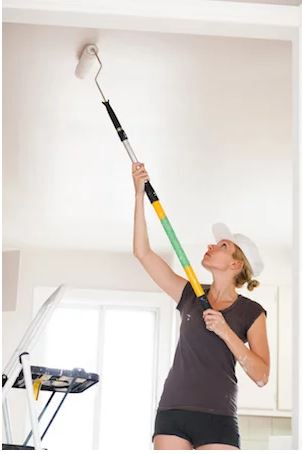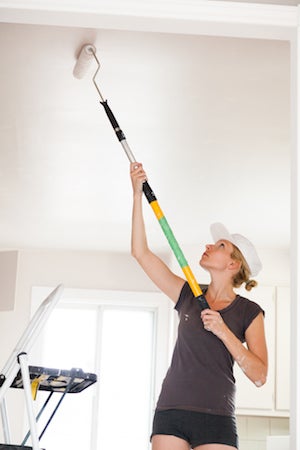DIY
EUREKA! Removing Water Stains From Your Ceiling.
One of our biggest pet peeves at home! Now, an easy DIY solution is available.
Photo: istockphoto.com
“Q: I recently noticed some water stains on the ceiling of my living room. I’m not sure where they came from, but the ceiling feels dry to the touch now. What’s the best way to cover them up? And since the stains are dry, can I assume that whatever caused them is no longer a threat to my home?
A: A water stain on the ceiling is usually a by-product of a roof, heating appliance, or plumbing leak that seeped through the ceiling and evaporated—leaving you with an unsightly patch of dried, discolored mineral deposits. A word of caution: If you cover up a water stain without addressing the leak that caused it, you run the risk of additional staining on the ceiling, not to mention more serious structural or electrical damage. That’s why it’s so important to find and repair the cause of the water stain as soon as possible, even if it is no longer wet. Follow the tips below to pinpoint and repair the cause of the stains, then clean, prime, and paint over the water stains to restore the blemish-free finish of your ceiling.
Identify and repair the root cause.
Your first priority when dealing with a water stain should be to find the source of the leak (or, in rarer cases, the flood) that caused it—the roof, the upstairs radiator, and the upstairs bathroom are good places to check.
• If the roof is to blame, find and repair and repair crumbling shingles, compromised flashing (the weatherproofing material installed on the roof), or weakened seals around roof vents, all of which can give way to leaks. If you cannot patch the leak in the roof, you may need to replace it.
• If it looks to be a leaky radiator, search out and fix the radiator body, valve, pipe, or bleed point (where cold air escapes from the radiator).
• If coming from the upstairs bathroom, replace old caulking that may be letting moisture seep in and encouraging leaks. Also, repair overflowing toilets and unclog clogged sinks or shower drains that could flood the bathroom floor with water.
Make the necessary repairs, or get the help of a professional roofer, HVAC professional, or plumber as needed, and you should be able to prevent future leaks—and water stains—on the ceiling.
Clean the stain with bleach.
Now that you’ve dealt with the underlying problem, you’re ready to tackle the stain itself—starting with a thorough cleaning. Cleaning the stained area of the ceiling with a mild homemade bleach solvent (one cup of bleach and three cups of warm water) will fade the stain and remove any lingering mildew, grease, dirt, or dust that can prevent primer and paint from adhering to the ceiling.
Photo: istockphoto.com
Start by setting a drop cloth on the floor below the ceiling stain and propping up a ladder to reach it. Donning protective gloves and goggles, climb up the ladder and wipe down the stain with a clean sponge saturated in the bleach solution. Rinse the bleach solution off the ceiling with water from a spray bottle, then dry the damp area with a clean cloth. Once the ceiling is completely dry, cover the ceiling trim with painter’s tape to protect it from primer and paint.
Apply a base coat of stain-blocking primer.
It can be tempting to slap a coat of paint directly over the water stain at this stage and call it a day. However, interior latex paints—which are commonly applied to ceilings—are a poor choice for a base coat over a water stain because they’re water-soluble. When a water stain comes into contact with latex paint, the stain dissolves into the wet paint layer as the paint dries, causing the discolored mineral contents of the stain to show through the paint to the ceiling surface once again.
Your best option for a base coat to cover water stains on the ceiling is an oil-based, mold-resistant, stain-blocking primer (such as Kilz Oil-Based Stain-Blocking Primer) in the shade closely matching that of the existing ceiling. Oil-based stain-blocking primers are water-insoluble. Therefore, water stains cannot bleed through. Unlike latex paint, these stain-blocking primers also contain a high volume of binders (polymers that bind paint pigments), so that the primer can effectively adhere to the surface over the long run.
Primer (and paint) application depends on your ceiling style. If you have a smooth ceiling, roll the primer over the water stains using a paint roller with an extension and a ⅜-inch nap roller cover, then let the primer dry for two hours or as instructed by the primer packaging. If you have a textured ceiling, opt instead for a thicker nap roller cover (¾ inch to 1-¼ -inch nap) or spray on the primer using a can of stain-blocking primer (such as Zinsser Cover Stain Primer).
Cover the primer with ceiling paint.
The primed area of the ceiling will usually be a few shades lighter or darker than the rest of the ceiling, which can draw the eye to the stained area. Painting over the primed area will help color-match it with the rest of the ceiling for a professional-quality cover-up. Whether you have a smooth or textured ceiling, you can use either a latex (water-based) or an alkyd (oil-based) ceiling paint over the oil-based primer—though latex options dry faster and produce fewer fumes from volatile organic compounds (VOCs) than oil-based counterparts. Make sure to purchase ceiling-specific paint, which is usually thicker than traditional paint and comes in a non-reflective finish that helps hide minor blemishes. Choose a paint that matches the color of your ceiling for a uniform look, then apply it over the primed area with a roller (choose a ⅜-inch nap cover for a smooth ceiling or an ¾ inch to 1-¼ inch nap for a textured ceiling). Let the first coat of paint dry for up to four hours or as instructed by the packaging, then apply a second coat for more even coverage. After the second coat dries, the ceiling should look as though there were never any water stains.”
Source : https://www.bobvila.com/articles/water-stains-on-ceiling/?#.WXi1MIjyuUk



